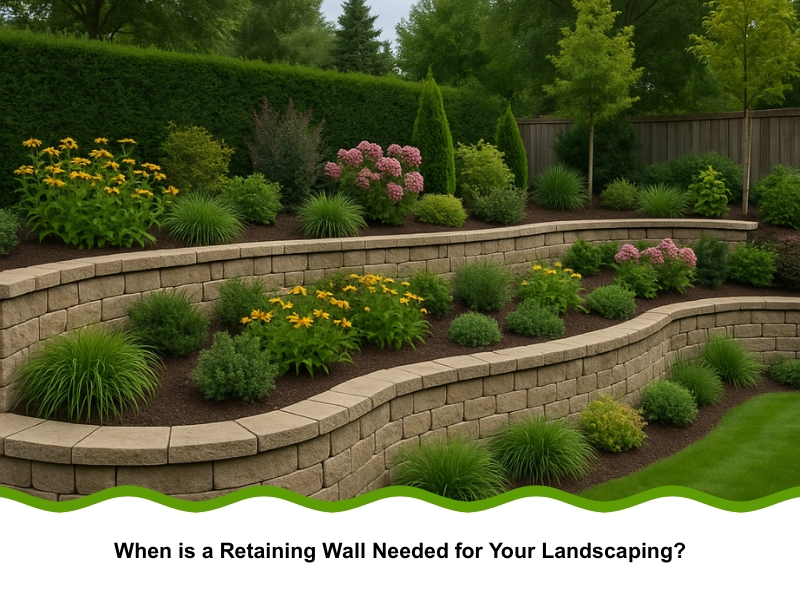Landscaping is not just about planting flowers and mowing lawns – it’s about creating a balanced, functional outdoor space. If you’re looking to manage slopes, prevent soil erosion, or simply enhance your garden’s aesthetics, a retaining wall might be exactly what you need. In fact, a retaining wall could be the missing element you never realised you needed to bring structure and stability to your outdoor area. But when is it truly necessary? In this article, we’ll explore the purpose of retaining walls, the types that work best for your garden, associated costs, the potential pitfalls of DIY projects, and who can help you decide if one is required.
What is the purpose of a retaining wall in landscaping?
A retaining wall plays a crucial role in managing soil and water in your outdoor space. Essentially, it is a structure designed to hold back soil and prevent erosion in areas with a sloped garden or uneven terrain. Below are some key purposes of a retaining wall:
- Soil erosion control: Retaining walls help to hold soil in place, especially on sloped land. Without them, heavy rains or wind can cause soil to slide or wash away.
- Levelling out sloped areas: If your garden is on a hill or incline, a retaining wall can create flat areas for planting or use. This allows you to make the most of your space.
- Creating usable outdoor space: Retaining walls can create multiple levels in a garden, enabling terraces for flowers, vegetables, or even outdoor seating areas.
- Aesthetic appeal: Besides function, retaining walls can add charm and structure to your landscaping, improving the overall look and feel of your yard.
What types of retaining walls are most suitable for your needs?
There are several types of retaining walls, each with its own advantages. The best choice for your landscaping depends on your specific needs, such as the height of the slope, soil conditions, and the aesthetic you’re after. Here’s a breakdown:
| Type of Retaining Wall | Best For | Materials | Pros | Cons |
| Gravity Walls | Low to medium-height slopes | Stone, concrete, or brick | Simple, durable | May require drainage |
| Cantilevered Walls | Taller slopes | Concrete | Strong, can handle large loads | Expensive, needs a solid foundation |
| Counterfort Walls | Steep slopes, large projects | Concrete | Highly efficient, saves material | Expensive to install |
| Anchored Walls | Very steep slopes | Steel cables, concrete | Great for steep areas | Requires professional installation |
| Timber Walls | Shorter, less demanding jobs | Wood, timber sleepers | Natural look, cheaper | Prone to weathering, may need more maintenance |
Tip: For residential projects in Sydney’s varying climates, gravity or timber walls are often suitable for smaller spaces, while concrete or anchored walls work better for larger, steeper slopes.
How much does it cost to build a retaining wall?
Building a retaining wall in Sydney depends on various factors, such as the size, materials, and complexity of the design. Below is a general price guide to help you understand the costs involved:
| Type of Wall | Estimated Cost (per meter) | Materials & Labour Costs |
| Timber | $150 – $350 | Basic materials, lower maintenance |
| Stone or Brick | $300 – $500 | Natural materials, more labour |
| Concrete | $350 – $700 | High durability, modern finish |
| Dry Stack Stone | $500 – $800 | Rustic look, complex labour |
| Steel/Concrete Anchored | $800 – $1,500 | Highly durable, professional installation |
Keep in mind that these prices are estimates, and the final cost may vary based on the size of the wall, the terrain, and any additional design elements. Always request a quote from a trusted landscaping professional to get a more accurate estimate based on your project.
Why should you avoid DIY retaining wall projects?
While it’s tempting to take on a DIY retaining wall project, there are several reasons why it’s best left to professionals. Here’s why:
- Drainage issues: A key part of a retaining wall’s function is managing water flow. Proper drainage behind the wall can prevent water buildup, which could lead to wall failure or flooding.
- Structural integrity: Retaining walls are designed to withstand significant pressure from soil and water. Improper installation can lead to failure, causing property damage or creating a safety hazard.
- Building codes: In some areas, building a retaining wall requires approval or permits. Professionals are well-versed in local regulations, ensuring compliance and saving you time and hassle.
- Long-term durability: A poorly constructed retaining wall may not provide the support needed, resulting in repairs or replacement sooner than expected and higher future costs.
Hiring professionals for your retaining wall ensures functionality, safety, and long-lasting results.
Who can advise you if a retaining wall is required?
If you’re unsure whether a retaining wall is necessary, it’s always best to consult a professional. Here’s who can help:
- Landscaping specialists: An experienced landscaper can assess whether a retaining wall is needed and provide recommendations based on your goals and budget.
- Structural engineers: For larger, more complex projects (especially on steep slopes or heavy soil), a structural engineer can assess the soil conditions and determine the best materials and design for a retaining wall.
- Builders: For retaining walls tied into new construction, a builder can help integrate the wall into the overall design of your property.
Conclusion
Building a retaining wall can dramatically improve both the function and appearance of your garden, especially in sloped or uneven areas. Whether you need to manage soil erosion, create more usable outdoor space, or add a touch of style, a retaining wall is a solid investment. If you’re considering adding a retaining wall to your landscaping, the experts at A1 Gardening & Landscaping Services can help. With years of experience serving Sydney residents and businesses, we’ll ensure your project is built to last and fits seamlessly with your outdoor space.


